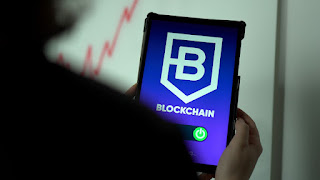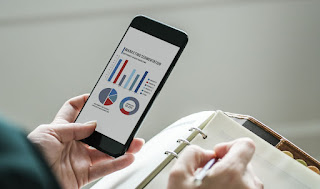User Data Security in Mobile Apps: Role of Blockchain Technology
In this blog, we will explore the effects of Blockchain technology on mobile apps, mainly focusing on how it improves app security. To understand this we first need to know what Blockchain is. Blockchain is a method of storing data that makes it difficult or even impossible to alter, hack, or manipulate the data. It stores the data in a block that is connected to other blocks in the form of a chain through peer to peer-to-peer connection. This storage structure can also be referred to as a digital ledger. It's basically like a Google spreadsheet with data transactional records in it which is shared among a network of people. The best part is that everybody can see the data in blockchain but they cannot alter it or destroy it.
Blockchain technology is being adopted by many sectors and getting popular by every passing day. Health, banking, real estate, education all these sectors and many more are already affected by this technology. According to an article By 2030, the market for blockchain technology will be valued at $1,431.54 billion, expanding at a CAGR of almost 85.9%. Hence the future of data security is blockchain, and mobile applications are no exception.
Furthermore, the most recent developments see blockchain as a safe database that any mobile app may use. To maintain track of transactions conducted by several parties and to provide these transactions to all parties involved, the technology is being used as a decentralized ledger. This enhances the app's security features and system transparency.
How Blockchain Can Secure User Data in Mobile Apps
The use of mobile apps is increasing drastically, and mobile apps are becoming a part of our daily lives. However, many apps in the market are facing issues related to the security of the application. As we know for the user privacy matters the most and for the developers, the user matters the most. So due to a lack of security user’s data and information is vulnerable to many malicious attacks which can cause distress to the users and thus the downfall of the application. This is the part where Blockchain technology comes in as a hero to save us all.
Immutability
Blockchain is a system for storing data in the form of a chain across a network of computers. Data cannot be altered or destroyed after it is added to blocks on the blockchain, making it hard for hackers to do so. Every new block includes a reference to the prior block because of how the blockchain works. Because of this, even if the hacker succeeds in corrupting the data of a single block, he or she will still need to change the data of every other block, which is practically and logically impossible.
Transparency
Being a transparent ledger, the blockchain decentralized system allows all transaction data to be visible to all the users in the network and all the data records to be recorded. Every party in the network has real-time access to the ledger this aspect gives control to the users for their data and allows them to see how their data is being used. Moreover, due to the transparency of the ledger, no party can alter data in the block without getting caught, as it is easier to track and audit transactions that prevent fraud and corruption.
Decentralization
Information in a decentralized blockchain is distributed among a network of computers, computers each called a node. To prevent a single node from having control over the blockchain's data all the nodes are provided with a complete copy of the blockchain. It is highly difficult for any malicious actor to jeopardize the data and alter the integrity of the system. Therefore, no one entity has control over it. So there is no single point of failure, it is more resistant to attack.
Security
Strong cryptography is used by the blockchain to protect data. Your users will be able to save, access, and manage all the transaction-specific data and information in one location by employing cryptography to assign private keys to the users. This indicates that data is encrypted and that only authorized users can decrypt it. By doing this, you can guard against unauthorized access, alteration, and loss of data.
Privacy
The owners of mobile apps can move the danger of hacking to the Blockchain by keeping the DNS entry there. Without the consent of the users, even the government cannot access the distributed, transparent DNS that the technology delivers. By encrypting data and only allowing authorized people to access it, blockchain is used to maintain user privacy. This might assist in limiting unauthorized access to private information like financial or medical records.
Examples of Blockchain-based Mobile Apps
Now we will learn about some apps that use blockchain technology for their data.
1. MediLedger
Tracking the transportation of prescription medications is done using the blockchain-based platform MediLedger. By doing so, you can guard against fake medicines and guarantee the efficacy and security of your prescriptions.
2. WeTrust
WeTrust is a peer-to-peer lending network built on the blockchain. This can make it easier for customers to obtain loans without going via a conventional bank.
3. Walmart
Walmart is tracking the flow of food goods across its supply chain using blockchain. This can support ensuring the food's safety and quality.
4. Trackr
The platform Trackr uses blockchain technology to track the movement of assets. Loss and theft can be avoided in this way.
Blockchain will increasingly be incorporated into mobile apps across a variety of industries in the upcoming years. This will provide the companies with extremely secure mobile solutions.
Before blockchain can be extensively used in mobile apps, there are still a few issues that need to be resolved. The high cost of development, the ignorance of users, and the lack of regulatory clarity are some of these difficulties. Despite these challenges, the advantages of blockchain in mobile apps are substantial. In the upcoming years, we may anticipate seeing an increase in the number of blockchain-based mobile apps created and used.
For custom software development, visit us at Zee Palm
Free free front-end flutter kits, visit Flutter Coded Templates
Check out free Flutter Components, visit Flutter Components Library



Comments
Post a Comment